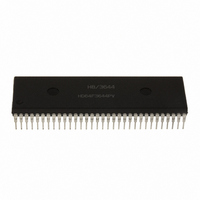HD6473258P10 Renesas Electronics America, HD6473258P10 Datasheet - Page 199

HD6473258P10
Manufacturer Part Number
HD6473258P10
Description
IC H8 MCU OTP 32K 64DIP
Manufacturer
Renesas Electronics America
Series
H8® H8/325r
Datasheet
1.HD6413238F10.pdf
(301 pages)
Specifications of HD6473258P10
Core Processor
H8/300
Core Size
8-Bit
Speed
10MHz
Connectivity
SCI, UART/USART
Number Of I /o
53
Program Memory Size
32KB (32K x 8)
Program Memory Type
OTP
Ram Size
1K x 8
Voltage - Supply (vcc/vdd)
4.5 V ~ 5.5 V
Oscillator Type
External
Operating Temperature
-20°C ~ 75°C
Package / Case
64-DIP
Lead Free Status / RoHS Status
Contains lead / RoHS non-compliant
Eeprom Size
-
Data Converters
-
Peripherals
-
Available stocks
Company
Part Number
Manufacturer
Quantity
Price
Company:
Part Number:
HD6473258P10
Manufacturer:
EXEL
Quantity:
6 218
Company:
Part Number:
HD6473258P10V
Manufacturer:
RENESAS
Quantity:
600
Part Number:
HD6473258P10V
Manufacturer:
HITACHI/日立
Quantity:
20 000
- Current page: 199 of 301
- Download datasheet (2Mb)
If the last bit of the next byte is received while the RDRF bit is still set to 1, an overrun error
occurs. The error is handled as described under “Data Reception” above. The overrun error does
not affect the transmit section of the SCI, which continues to transmit normally.
9.4 Interrupts
The SCI can request three types of interrupts: transmit-end (TXI), receive-end (RXI), and receive-
error (ERI). Interrupt requests are enabled or disabled by the TIE and RIE bits in the SCR.
Independent signals are sent to the interrupt controller for each type of interrupt. The transmit-end
and receive-end interrupt request signals are obtained from the TDRE and RDRF flags. The
receive-error interrupt request signal is the logical OR of the three error flags: overrun error
(ORER), framing error (FER), and parity error (PER). Table 9-9 lists information about these
interrupts.
Data transmitting and receiving start when the TDRE bit in the SSR is cleared to 0.
Data are sent and received in synchronization with eight clock pulses.
First, the transmit data are transferred from the TDR to the TSR. This makes the TDR empty,
so the TDRE bit is set to 1. If the TIE bit is set to 1, a transmit-end interrupt (TXI) is requested.
If continuous data transmission is desired, software must read the TDRE bit in the SSR, write
the next transmit data in the TDR, then clear the TDRE bit to 0.
If the TDRE bit is not cleared to 0 by the time the SCI finishes sending the current byte from
the TSR, the TxD pin continues to output the value of last bit of the previous data.
In the receiving section, when 8 bits of data have been received they are transferred from the
RSR to the RDR and the RDRF bit in the SSR is set to 1. If the RIE bit is set to 1, a receive-
end interrupt (RXI) is requested.
To clear the RDRF bit software should read the RDRF bit in the SSR, read the data in the RDR,
then write a 0 in the RDRF bit.
For continuous data reception, software should clear the RDRF bit to 0 before reception of the
next 8 bits is completed.
192
Related parts for HD6473258P10
Image
Part Number
Description
Manufacturer
Datasheet
Request
R

Part Number:
Description:
KIT STARTER FOR M16C/29
Manufacturer:
Renesas Electronics America
Datasheet:

Part Number:
Description:
KIT STARTER FOR R8C/2D
Manufacturer:
Renesas Electronics America
Datasheet:

Part Number:
Description:
R0K33062P STARTER KIT
Manufacturer:
Renesas Electronics America
Datasheet:

Part Number:
Description:
KIT STARTER FOR R8C/23 E8A
Manufacturer:
Renesas Electronics America
Datasheet:

Part Number:
Description:
KIT STARTER FOR R8C/25
Manufacturer:
Renesas Electronics America
Datasheet:

Part Number:
Description:
KIT STARTER H8S2456 SHARPE DSPLY
Manufacturer:
Renesas Electronics America
Datasheet:

Part Number:
Description:
KIT STARTER FOR R8C38C
Manufacturer:
Renesas Electronics America
Datasheet:

Part Number:
Description:
KIT STARTER FOR R8C35C
Manufacturer:
Renesas Electronics America
Datasheet:

Part Number:
Description:
KIT STARTER FOR R8CL3AC+LCD APPS
Manufacturer:
Renesas Electronics America
Datasheet:

Part Number:
Description:
KIT STARTER FOR RX610
Manufacturer:
Renesas Electronics America
Datasheet:

Part Number:
Description:
KIT STARTER FOR R32C/118
Manufacturer:
Renesas Electronics America
Datasheet:

Part Number:
Description:
KIT DEV RSK-R8C/26-29
Manufacturer:
Renesas Electronics America
Datasheet:

Part Number:
Description:
KIT STARTER FOR SH7124
Manufacturer:
Renesas Electronics America
Datasheet:

Part Number:
Description:
KIT STARTER FOR H8SX/1622
Manufacturer:
Renesas Electronics America
Datasheet:

Part Number:
Description:
KIT DEV FOR SH7203
Manufacturer:
Renesas Electronics America
Datasheet:











